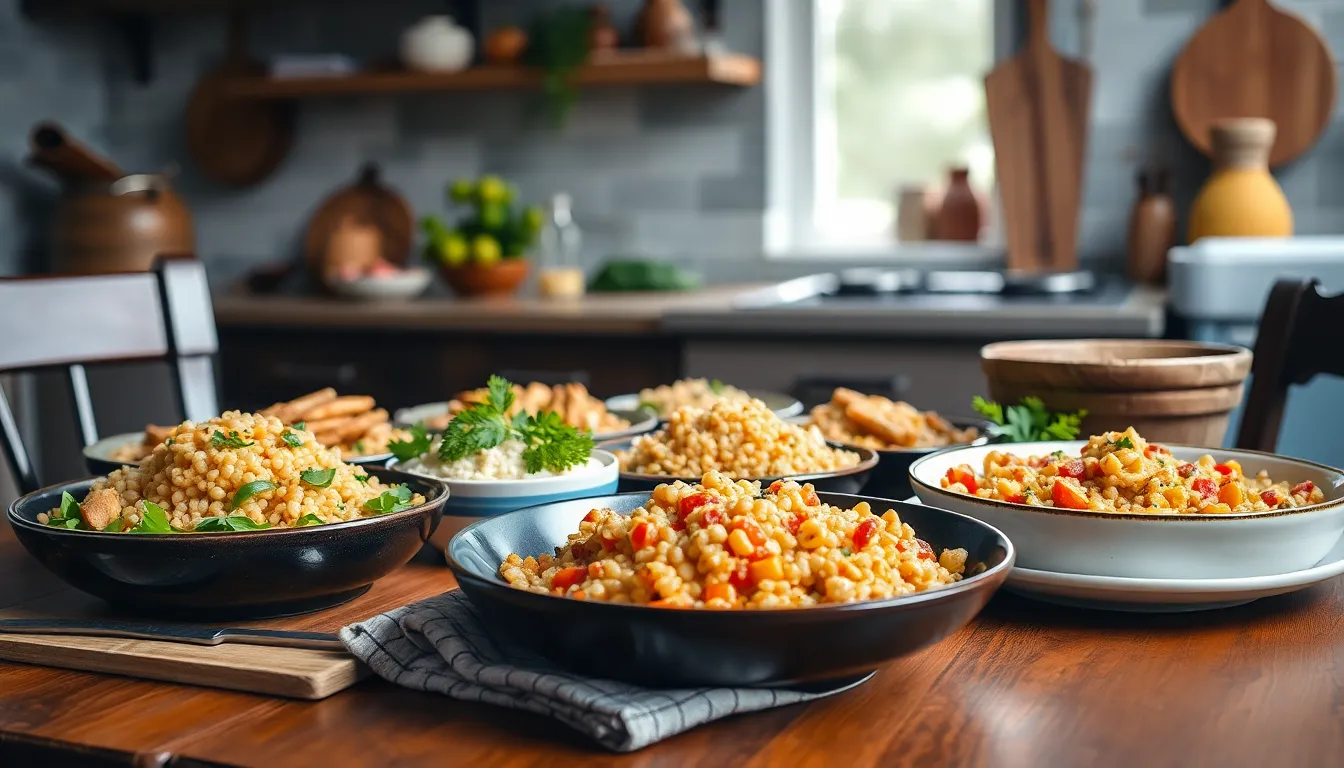Barley might not be the star of the show in most kitchens, but it’s time to roll out the red carpet. This humble grain is a powerhouse of nutrition and flavor just waiting to steal the spotlight. With its nutty taste and chewy texture, barley can elevate any dish from mundane to magnificent.
Table of Contents
ToggleOverview of Barley Cooking Techniques
Barley cooking techniques offer diverse methods to prepare this nutritious grain. Boiling is one of the simplest techniques. To boil barley, combine one part barley with three parts water in a pot. Bring it to a boil, then reduce the heat and simmer for 30 to 40 minutes until tender.
Soaking barley before cooking can enhance its texture. Placing barley in water for several hours or overnight leads to quicker cooking times. This method reduces the overall cooking duration significantly.
Steaming provides another healthy option that retains barley’s nutrients. Using a steamer basket, cook soaked barley over boiling water for 20 to 25 minutes. Steaming also enhances the grain’s natural flavors.
Baking barley introduces a different appeal to recipes. Mixing cooked barley with vegetables or protein creates a flavorful casserole. A temperature of 350°F for about 30 minutes allows all ingredients to meld together.
Using barley as a grain base for salads creates a refreshing dish. Mixing cooked barley with chopped vegetables, herbs, and a tangy dressing elevates flavor. This method showcases barley’s versatility and ability to absorb seasonings.
Pressure cooking barley reduces cooking times significantly. This method cooks soaked barley in an electric pressure cooker or stovetop unit in about 10 to 15 minutes. The pressure cooker ensures even cooking while saving time.
Incorporating barley into soups and stews enriches overall texture and nutrition. Adding cooked barley directly into dishes during the last 20 minutes of cooking allows it to absorb flavors without becoming mushy. Each technique serves to highlight barley’s adaptability and nutritional benefits.
Types of Barley

Barley comes in various forms, each offering unique characteristics that enhance culinary applications. Understanding these types aids in selecting the best fit for specific dishes.
Hulled Barley
Hulled barley retains its bran layer, making it a whole grain option. High fiber content in hulled barley promotes digestive health, while its nutty flavor complements salads and soups. Cooking hulled barley requires more time than other types, usually around 50 to 60 minutes. Soaking the grain beforehand can reduce cooking time. Utilizing hulled barley in stews adds a hearty texture and absorbs surrounding flavors well.
Pearl Barley
Pearl barley undergoes a polishing process, removing the bran layer and imparting a softer texture. While it offers fewer nutrients than hulled barley, its cooking time is significantly shorter, around 30 minutes. Pearl barley’s mild flavor makes it a versatile ingredient in risottos and casseroles. This form of barley readily absorbs flavors, enhancing the taste of dishes. Chefs often appreciate its creamy consistency when cooked, ideal for comforting meals.
Cooking Methods for Barley
Barley boasts diverse cooking techniques that enhance its flavor and texture. Each method offers unique benefits, making barley an even more versatile ingredient in various dishes.
Boiling
Boiling presents the simplest way to cook barley. Start with a ratio of three cups of water to one cup of barley. Bring the water to a boil, add the barley, and reduce the heat to simmer. Cook hulled barley for 50 to 60 minutes, while pearl barley takes around 30 to 40 minutes. Stir occasionally to prevent sticking. Once the water absorbs, the barley becomes tender and ready for salads or soups. Boiling retains most of the grain’s nutrients, giving it a wholesome profile.
Steaming
Steaming helps retain barley’s nutritional value while achieving a delightful texture. Use a steamer basket over boiling water for this method. Rinse barley thoroughly and fill the basket with the grain. Steam hulled barley for about 45 minutes and pearl barley for 20 to 25 minutes. The result showcases tender grains that maintain a firm bite, making them ideal for salads. Steaming preserves flavor and nutrients better than boiling, keeping the dish healthy and vibrant.
Baking
Baking introduces a unique twist to barley preparation. Combine cooked barley with vegetables, broth, and seasonings in a casserole dish. Preheat the oven to 350°F before covering the dish with aluminum foil. Bake for approximately 30 to 40 minutes, allowing flavors to meld. Baking results in a hearty meal with a comforting texture, perfect for cold weather. The caramelization of vegetables alongside barley adds depth to the dish, elevating its taste while showcasing barley’s adaptability.
Flavoring and Pairing Barley Dishes
Flavoring barley dishes enhances their appeal, enabling cooks to explore diverse culinary possibilities. By experimenting with various herbs and spices, barley’s natural flavor shines through.
Herbs and Spices
Fresh herbs like parsley, cilantro, and dill elevate barley freshness. Dried spices, including cumin, coriander, and paprika, provide warmth and depth. Adding garlic and onion boosts the savory profile, creating a robust base. Mustard and turmeric offer a unique twist, enhancing both flavor and health benefits. When preparing risottos or casseroles, incorporating thyme or rosemary adds aromatic complexity. Experimenting with these options helps chefs create balanced and delicious barley dishes.
Vegetable Combinations
Including a variety of vegetables in barley recipes diversifies the flavor profile. Carrots, bell peppers, and zucchini contribute sweetness and texture. Tomatoes add acidity, brightening up the dish while providing moisture. Spinach and kale introduce nutrient-dense greens, complementing barley’s hearty nature. Roasting vegetables enhances their natural flavors, creating a delightful contrast with barley’s chewiness. Combining these elements not only enriches the nutritional value but also elevates the overall dish.
Tips for Perfectly Cooked Barley
Achieving perfectly cooked barley involves several key steps. Start by rinsing the grains under cold water to remove dust and impurities. A proper water-to-barley ratio is crucial; use three parts water for every one part barley.
Soaking barley enhances texture and reduces cooking time. Soaking hulled barley for four to six hours yields the best results. Cook hulled barley for 40 to 50 minutes, while pearl barley requires only 25 to 30 minutes.
Adding flavor to cooking water is an effective technique. Incorporate broth or seasonings to enrich the barley. Fresh herbs like thyme or bay leaves infuse taste during cooking.
Simmering provides a gentle cooking environment. A steady simmer produces tender grains without excess moisture. Keep the lid on the pot to retain steam and heat, allowing grains to cook evenly.
After cooking, let barley rest off the heat for 10 minutes. This resting period allows grains to absorb any remaining liquid, preventing mushiness. Fluff with a fork to separate grains and enhance texture.
Optionally, toasting barley enhances its nutty flavor. Toast in a dry skillet for a few minutes before adding water. This method adds depth to dishes, particularly in salads and pilafs.
Use barley promptly or store it correctly. Refrigerate cooked barley in an airtight container for up to five days. For longer storage, freezing is an option, maintaining quality for up to three months.
Following these tips leads to perfectly cooked barley for various dishes, from hearty soups to refreshing salads.
Barley stands out as a nutritious and versatile grain that deserves a place in every kitchen. Its adaptability allows it to shine in a variety of dishes from salads to soups. By mastering different cooking techniques like boiling, steaming, and baking, anyone can unlock barley’s full potential.
Experimenting with flavor pairings and cooking methods not only enhances the taste but also elevates the overall dining experience. With its unique textures and flavors, barley can transform simple meals into hearty and satisfying options. Embracing this often-overlooked grain can enrich both culinary creativity and nutritional value, making it a worthy addition to any meal plan.




